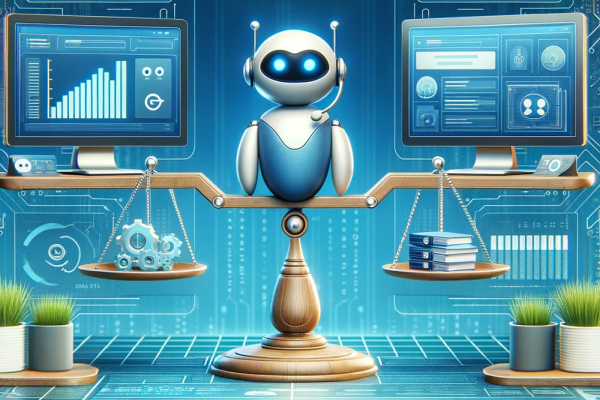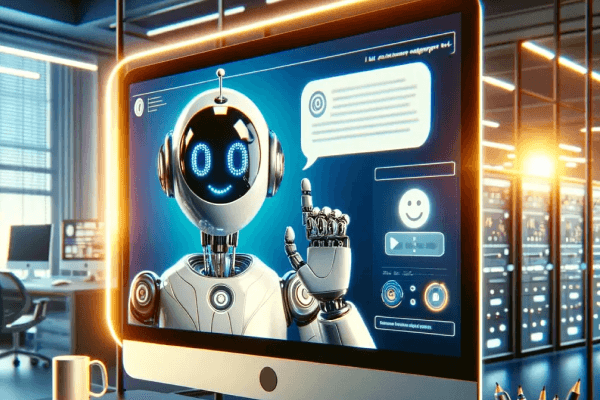AI can cut customer support costs by up to 30% while improving efficiency and customer satisfaction. Here’s how businesses are leveraging AI to reduce expenses:
- Cost Savings: AI tools like chatbots handle 80% of routine inquiries, saving as much as $1.31 per query and reducing operational costs by billions annually.
- Efficiency Gains: AI-powered tools speed up response times, reduce ticket volumes, and automate tasks like drafting email replies.
- Affordable Solutions: Tools like Resolve247.ai offer 24/7 support and features like auto-translation for as low as $14/month, making them accessible to small businesses.
- Combined Approach: A mix of AI and human agents ensures seamless handling of both simple and complex customer issues, cutting costs while maintaining quality.
Key Stats:
- 95% cost reduction per interaction reported by some businesses.
- $23 billion in potential savings through AI automation of 30% of tasks.
- 62% of customers prefer chatbots for quick, simple queries.
AI tools are transforming customer support by lowering costs, increasing efficiency, and enhancing customer experiences.
Measuring Current Support Expenses
Understanding your current support costs is key to pinpointing where AI can save money. A detailed cost breakdown helps you see the potential savings when AI is implemented.
Main Cost Factors
Staffing is usually the biggest cost in customer support, making up 25–35% of a company’s revenue [1]. Other major cost areas include technology (tools/platforms), training (costs of onboarding/skill development) and operational (overheads and infrastructure expenses).
Each customer interaction would normally cost anywhere from $1 to $50, depending on the complexity and the channel used [2].
Industry Cost Standards
In the B2B SaaS world, companies generally spend about 8.5% of their annual recurring revenue (ARR) on support. Larger companies (ARR over $100M) aim to keep this below 5%, while mid-sized companies (ARR between $10M and $100M) tend to spend 5–10% [5]. Comparing your spending to these benchmarks can help identify where AI could cut costs.
AI Investment Returns
AI chatbots can handle queries in just 1–5 seconds, compared to the 45 seconds it often takes human agents. This efficiency translates to about $1.31 saved per query [3].
One SaaS company shared impressive results in 2023:
- 30% drop in support costs within six months
- Response times cut from 10 minutes to under 1 minute
- 20% boost in customer satisfaction scores
Want to estimate your own savings? Multiply the number of routine queries per hour by the time saved per query (40 seconds) and your agents’ hourly pay rate.
AI Chatbots: Setup and Cost Benefits
AI chatbots help lower support costs while maintaining high service standards. Resolve247.ai simplifies the setup process and reduces expenses.
Choosing the Right AI Chatbot
When selecting a chatbot, look for one that integrates well with your current systems. Here are some features to prioritize:
| Feature | Cost Impact | Key Advantage |
|---|---|---|
| System Integration | Lowers setup costs | Works with your existing tools |
| 24/7 Availability | Reduces staffing needs | Answers queries anytime |
| Auto-translation | Cuts translation costs | Supports global customer base |
| Knowledge Base Training | Decreases upkeep costs | Uses your existing documentation |
Modern chatbots are packed with features designed to improve efficiency and deliver a solid return on investment.
Training for Accurate Responses
To ensure your chatbot provides accurate answers, train it with up-to-date support data. Use AI tools that can learn from your existing sources of knowledge, and auto update – to ensure the AI reduces your workload, not adding another maintenance task! This minimizes the need for manual intervention and further reduces costs.
"Our tools help you to work on the important things that humans do well, so you’re not answering the same questions repeatedly!" – Resolve247
Steps to Launch Your Chatbot
- Trial
Start with a 30-day trial, which can get started in just minutes. - Integrate
Connect your existing tools to expand the AI’s opportunity to assist. - Monitor
Track essential metrics like:- Response accuracy
- Time to resolve queries
- Ticket deflection rate
- Customer satisfaction
Research shows that businesses using AI chatbots can cut support costs by up to 30%, thanks to fewer tickets and quicker resolutions. This streamlined approach also sets the stage for automating more support tasks in the future.
sbb-itb-bd61b1a
AI Tools for Support Tasks
AI isn’t just about chatbots – it also helps cut costs by automating everyday support tasks. From sorting tickets to drafting email replies and updating documentation, these tools simplify processes and save time.
AI Ticket Sorting
AI-based ticket sorting takes the hassle out of manual categorization. For instance, Zendesk‘s AI saves users an average of 45 seconds per ticket compared to traditional methods [6]. Here’s how it works:
- Analyzes ticket content and urgency
- Directs issues to the right teams
- Prioritizes tickets based on complexity
- Tags tickets for better tracking
In March 2023, Khan Academy adopted Zendesk’s AI sorting, achieving a 92% customer satisfaction score thanks to better routing. This allowed them to handle growing ticket volumes without hiring more staff [6].
Auto-Generated Email Replies
Resolve247’s ResponseAssistant drafts email replies using your knowledge base and past responses. It ensures consistency in tone and accuracy by learning from previous interactions.
| Feature | Benefit | Cost Impact |
|---|---|---|
| Pre-drafted Responses | Speeds up replies | Saves agents’ time per ticket |
| Knowledge Base Integration | Delivers accurate answers | Cuts down on training expenses |
| Multi-language Support | Covers global audiences | Lowers translation costs |
AI-Assisted Documentation
AI tools can also keep support documentation up to date. Vercel’s system, launched in September 2024, brought noticeable improvements:
"The key to realizing these benefits lies in thoughtful implementation, ensuring that AI solutions complement rather than replace human expertise in customer support."
– Alina Weinstein, Sr. Product Marketing Manager, Vercel [8]
Their results included:
- 31% fewer tickets needing human intervention
- 16% drop in total support tickets during initial trials
- Boosted customer satisfaction with fast, accurate responses [8]
Medline provides another example, managing over 800,000 tickets annually while maintaining top-notch service quality [7]. This shows how AI can handle large volumes without compromising on support standards.
"With AI, you can provide excellent customer service without increasing your workforce."
– Zendesk [6]
Companies using AI in customer support have reported a 42% reduction in first response time [8]. The secret? Choosing tools that integrate smoothly with your systems and enhance, rather than replace, your human support team.
Combining AI and Human Support
Research indicates that 70% of customers prefer AI for straightforward issues, while 80% want human assistance for more complicated problems[10].
When to Switch to Human Agents
Having clear guidelines for when to involve human agents is crucial. Here are some common triggers for handing off to human agents:
| Scenario | Action | Benefit |
|---|---|---|
| Customer Request | Immediate transfer to a human agent | Respects customer preferences |
| Complex Issues | Auto-escalation after AI assessment | Avoids unnecessary frustration |
| High-Value Accounts | Direct routing to senior agents | Protects key relationships |
| Emotional Situations | Sentiment-based escalation | Ensures compassionate responses |
In addition to managing escalations, AI tools can make human agents more efficient.
AI Support for Staff
AI enhances the productivity of human agents without replacing them. For example, Resolve247’s ResponseAssistant allowed a support team to handle 50% more inquiries while maintaining quality standards.
"AI acts as a co-pilot, enhancing the capabilities of human team members rather than replacing them." – Mercer Smith, Author at PartnerHero[11]
In 2023, Ringly achieved impressive results: a 25% reduction in support costs, a 15% increase in customer satisfaction, and 60% of inquiries managed by AI[10].
Personal Touch in AI Support
Companies that successfully combine AI and human support can cut operational costs by up to 30% while boosting customer satisfaction by 20%[10].
"The key to optimizing customer support costs lies in knowing when to let AI handle inquiries and when to bring in human agents for a personal touch." – Jane Doe, Customer Experience Expert, Ringly[10]
Tools like ResponseAssistant use a human-in-the-loop approach so the AI can reduce workload, but still maintain a personalized approach by drafting brand-consistent replies, using past interactions for context, and offering multilingual support through automatic translation.
For an approach where the customer interfaces directly with AI, using AIChatbot applies a personal human touch by not trying to stop human contact, but proactively providing an answer if it is available, and otherwise helping the customer to contact a human.
To ensure smooth operations, companies should regularly monitor performance and refine escalation criteria. This approach keeps costs low while maintaining the personal attention needed for complex situations.
Conclusion: Reducing Costs with AI Support
Steps to Add AI Support
According to data, 73% of business leaders anticipate customer service will lead AI adoption in companies by next year [13]. Businesses can cut costs by following a structured approach to AI integration:
| Implementation Phase | Key Actions | Expected Outcome |
|---|---|---|
| Assessment | Examine current support costs and pinpoint automation opportunities | Establish baseline metrics |
| Tool Selection | Select AI tools compatible with existing systems | Smooth integration |
| Training | Equip support teams and AI models with high-quality data | Better accuracy |
| Monitoring | Measure performance metrics and customer satisfaction | Streamlined operations |
For instance, in February 2025, Supportbench highlighted a telecom company that implemented an AI chatbot, reducing response times by 50% and boosting customer satisfaction by 20% [12].
Once a strong AI framework is established, the next focus should be on integrating additional tools and improving operational processes.
Next Steps in AI Support
AI support is set to further streamline operations. Gartner projects conversational AI will cut contact center agent labor costs by $80 billion by 2026 [15]. To build on these savings, businesses should consider:
- Enhanced Integration: Use tools like Resolve247.ai for smooth compatibility with existing ticket systems, including features like auto-translation and custom AI behavior settings.
- Improved Efficiency: Generative AI has been shown to increase resolution rates by 14% while reducing handling times by 9% [14].
- Cost Optimization: Companies using AI tools report a 10% boost in productivity, leading to annual savings of about $146,000 [14].
"By 2025, businesses are expected to ramp up their investment in AI-driven customer experience tools, enabling instant multilingual support, sentiment analysis, and automated conversation summaries."
To stay competitive, companies should prioritize AI solutions that support and enhance their teams rather than replace them. Crescendo.ai noted in February 2025 that 63% of organizations have already begun training their customer service teams to effectively utilize AI tools [15].



